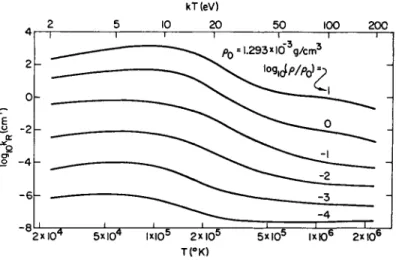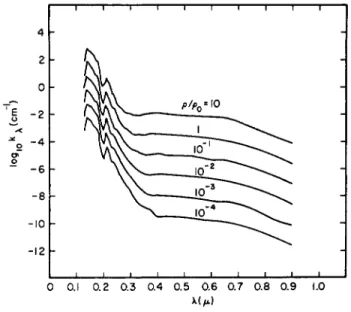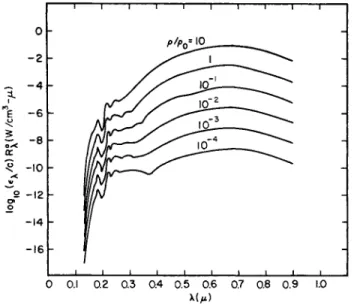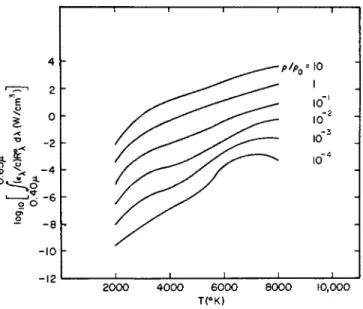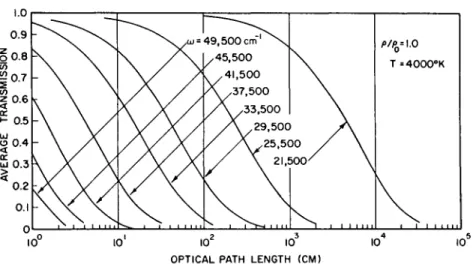Chapter 3
RADIATIVE HEAT
TRANSFER I N HEATED A I R * '
T h e calculation of radiative heat transfer rates can be carried out systematically only for a few limiting cases. In this chapter, we summarize existing data relevant to the optically thick, optically thin, and isothermal cases for air in local thermodynamic equilibrium (LTE), and close with some brief remarks on n o n - L T E radiation.
3-1 Limiting radiative transfer cases
Under the assumption of L T E , the radiative-energy transfer rate in a system depends on the spectral value of the photon mean free path /„(= I IK) and on the blackbody steradiancy Bv, suitably averaged over frequencies and positions. As was shown in detail in Section 2-2, the averaging process becomes simple for two important limiting cases.
(a) An optically thick system is one for which / „ < ^ L a t all v> w h e r eL is a typical system dimension. T h e radiative-energy flux vector at a point well inside such a system is given, in terms of local quantities, by the expression
F = - ^ / Rg r a d £ (3-1.1)
* Chapter 3 is by S. S. PENNER and J. C. STEWART.
+ A first draft of this chapter was prepared by S. S. Penner. The chapter was then extensively rewritten and revised by J. C. Stewart. It should be noted that the discussion in Sections 3-1 and 3-2 duplicates some of the analysis presented in Section 2-2. However, the point of view is somewhat different and, furthermore, the presentation is now completely self-contained and should allow reading of Chapter 3 without reference to the contents of Chapters 1 and 2.
188
where B is the integrated blàckbody steradiancy ( = σΤ*/π) and /R is the Rosseland mean free path. As was shown in Eq. (2-2.14),
/R = (dBJdT)lvdv _ _1_
dB/dT ~ £R' V-lmji)
where kK is the Rosseland mean absorption coefficient. Since the con- ductive energy flux is also proportional to the local temperature gradient, the radiative and conductive flux terms are directly additive. The op- tically thick case is sometimes called the opaque, diffusion, or Rosseland limit.
(b) For an optically thin system, lv^> L at all v. In this case, all radiation emitted by the system escapes without reabsorption, and the local radiative rate of energy loss, per unit volume and time, is Απΰφ, where kP is the Planck mean absorption coefficient given in Eq. (2-2.4a) viz.,
r*|* i
(3_
1<3)-f
J 0where /P is the Planck mean free path and kv is the linear absorption coefficient. The optically thin case is called the transparent, emission, or Planck limit.
(c) An isothermal and isobaric system has the same Bv and kv every- where; the specific intensity IV(L) of a ray, which has traversed a length L in such a system, after entering with incident intensity Λ,(Ο), is given
by
UL) = [/,(0) e x p ( - kvL)] + {B,[l - e x p ( - kj.)]}. (3-1.4) For heat-transfer computations, it is convenient to define a spectral transmission function TV(L) by the expression
r.(L)=4-f [exp(-A^L)]*, (3-1.5)
where Av is sufficiently large to contain, for example, many lines of a molecular band [and thereby smoothes out the most fine-grained part of the frequency dependence of exp(—kvL)] but small enough that Bv may be taken as constant within Δν. If Iv(0) Φ 0, it must likewise be nearly constant in Av for rv(L) to be relevant. The average value of IV(L) in Av>
</„(!/)), is given by the relation
</,(L)> = </,(0)> rv{L) + (Bvy [1 - T„(L)]. (3-1.6) The quantity 1 — rv(L) is the spectral emissivity (or absorptivity) for
radiation emitted (in Av), in a direction normal to the face of a slab of
190 3 . RADIATIVE PROPERTIES OF HEATED AIR
thickness L. The emissivity for a direction making an angle Θ with respect to the outward normal is 1 — rv(L sec Θ); the total radiative rate of energy loss from the slab (both faces), per unit volume and time, is then obtained by deriving a proper average over all angles [cf. Eq.
(2-1.23)]. The result is
2F+(0) = 4πΒ f1 [1 - r(L^)] μ άμ (3-1.7)
J o
where μ = cos 0, and τ is the Planck-weighted average transmission
T ( L ) = CrXL)BvdvlB. (3-1.8)
J o
We note that the energy-loss rate reduces properly to the Planck limit;
thus, if kvL <έζ 1 (for all v), then T(L) —> 1 — kpL. In general, however, the ratio of actual to Planck-limit rates, 8%, is less than unity, where
®=h\ x \ x ~ T 0V d ^ x - (3 - K9)
The spectral transmission may also be used to obtain the Rosseland mean, as follows:
Γ τ ^ ) Λ = <1/Α,) = < 0 . (3-1.10)
J 0
Here <(/„> may be substituted for lv in the defining integral of Eq. (3-1.2) for lR .
The frequency-averaged emissivity per unit path length, e(L) = [1 - r{L)]jL,
depends on L and approaches kP as L —► 0. T h e replacement of e(L) by kP
is valid only if kvL <^ 1 (for all v); in the literature, the incorrect and less stringent criterion kpL <^ 1 is sometimes quoted. T h e difference between these criteria is especially large when most of the emission occurs from a few narrow spectral lines.
3-2 Existing absorption-coefficient data for heated a i r1 - 9 T h e calculation of the absorption coefficient kv and its various averages for heated air falls naturally into two temperature ranges: below about 9000° K (at normal density) air consists mostly of diatomic and triatomic molecules, and above this temperature it consists mostly of atoms, atomic ions, and free electrons. T h e boundary between these "mole- cular" and "atomic" regimes depends somewhat on density and is not sharply defined.
Because of the multitude of absorption lines which contribute strongly
to kv in both the atomic and molecular regimes, it is not practical to try to exhibit the full fine-grained frequency dependence of kv(ov lv).
Instead, averages over frequency intervals Δν (see Section 3-1) of kv, lv, or exp(—kvL) are employed, corresponding to "local" (in frequency space) Planck, Rosseland, and transmission averages, respectively. These are not interchangeable; thus (kv} Φ 1/</„>. Since <&„>, unlike the other local averages, is essentially independent of spectral line profiles and depends only on integrated line strengths, it is the local average most often presented. The full Planck and Rosseland means (kF, kR) are still more widely used.
Numerical data for the various averages of kv have been revised markedly in recent years through the inclusion of formerly neglected absorption mechanisms, such as the vibration-rotation bands of the NO molecule and atomic line absorption. The revisions amount to several orders of magnitude in some cases; the Planck mean in Armstrong et al.,1 for example, is far below more recent data at most temperatures. Since further revision is possible, the "current" data should not be regarded as immutable. Some recent calculations for air* are summarized in Table 3-2.1.
The results of Gilmore5 up to T = 8000°K, Armstrong et al.2 from kT = 1 to 20 eV, and of Cox and Stewart3 above 20 eV, are shown in Figs. 3-2.1 and 3-2.2, where Rosseland and Planck means are given, respectively. Spectral data from Churchill et al.* and Gilmore5 are shown in Figs. 3-2.3 through 3-2.22.
TABLE 3-2.1
CALCULATIONS OF RADIATIVE ABSORPTION COEFFICIENTS FOR HEATED AIR
Type of average Molecular regime Atomic regime Rosseland
Planck
Local Rosseland Local Planck
Local transmission
Gilmore5
Gilmore5; Churchill et al.7
Churchill et al. ;4 Churchill and Hagstrom,8 including the NO vibration-rotation bands
Armstrong, et al. ;2
Cox and Stewart;3 Freeman6 Armstrong et al. ;2 Freeman6
Freeman6 Churchill et al.7
(without atomic lines)
* After this chapter was completed, an additional relevant publication appeared by Buttrey and McChesney.9a
5X10°
T(°K)
FIG. 3-2.1. Rosseland mean absorption coefficient of air as a function of temperature and density; plotted from the data listed in Armstrong et al.2 and Cox and Stewart.3
2000 4000 6000 8000 12000 20,000 50,000 100,000 200,000 TCK)
FIG. 3-2.2. Planck mean absorption coefficient of air as a function of temperature and density; plotted from the data listed in Armstrong et al.2 and Gilmore.5
4 2 0
TÉ - 2
o
" - 6 - 8 -10 -12
0 0.1 0.2 0.3 0.4 0.5 0.6 0.7 0.8 0.9 1.0
FIG. 3-2.3. Absorption coefficients of high-temperature air as a function of wave- length at 2000°K; plotted from the data listed in Gilmore.5
4 2 0 τΐ -2
o σ>
o
" - 6 - 8 -10 -12
0 0.1 0.2 0.3 0.4 0.5 0.6 0.7 0.8 0.9 1.0 LtO
\{μ)
FIG. 3-2.4. Absorption coefficients of high-temperature air as a function of wave- length at 3000°K; plotted from the data listed in Gilmore.5
T 1 1 1 1 1 1 i
' ■ ■ ■ I I I L
I I 1 1 1 1 1 Γ
J I I I I I I I L
194 3 . RADIATIVE PROPERTIES OF HEATED AIR
H I I P π 1 1 1 r
i I |_
0 0.2 0.4 0.6 0.8 1.0 1.2 1.4 1.6 1.8 2.0
FIG. 3-2.5. Absorption coefficients of high-temperature air as a function of wave- length at 4000°K; plotted from the data listed in Gilmore.5
i I I I i
i i i i
0 0.2 0 4 0 6 0.8 1.0 1.2 1.4 1.6 1.8 2.0
\(μ)
FIG. 3-2.6. Absorption coefficients of high-temperature air as a function of wave- length at 6000°K; plotted from the data listed in Gilmore.5
1 1 1 r H 1 1 ι r
j ' ' i L·
0 0.2 0.4 0.6 0.8 1.0 1.2 1.4 1.6 1.8 2.0 λ(/ι)
FIG. 3-2.7. Absorption coefficients of high-temperature air as a function of wave- length at 8000°K; plotted from the data listed in Gilmore.5
0 - 2
~ - 4
1
TE - 6
^ Ξ
^ - 8 o*< ° cc Z -10
<<
w 2 -12 σ>
o -14 -16
1 1
I///V/
1- ■///A/
1/
1 1
— i 1 r
p'pj
1 L- 1
i 1 1
10
1 ^ ^ ^
ί~^
J 2 ^ — ^ "JSC
^ ^
1Λ-4 "^·
10
1 1 „, 1
— ι 1 1
J
-1
J
J
1 1
0 0.1 0.2 0.3 0.4 0.5 0.6 0.7 0.8 0.9 1.0
FIG. 3-2.8. Emission coefficient of high-temperature air as a function of wavelength at 2000°K; plotted from the data in Gilmore.5
196
4 2 0
"fe -Z
or 4e - 6
-<
WS - 8 o
-10 -12
i — ' — ' — η
-
/ γ \
\fp
1_ _ 1. 1
■ ■ " ■ T— T ■ i ■ i 1 1—
p/p^O
I ^ " ^
^ ^
v -—2lT^
^^_ _3?^
^*\ -—^1^_
_ _ L 1 J i 1 1
—i
A
A
^ ^ j
H
1 ., J 0 0.1 0.2 0.3 0.4 0.5 0.6 0.7 0.8 0.9 1.0 1.10
FIG. 3-2.9. Emission coefficient of high-temperature air as a function of wavelength at 3000°K; plotted from the data in Gilmore.5
FIG. 3-2.10. Emission coefficient of high-temperature air as a function of wavelength at 4000°K; plotted from the data in Gilmore.5
0 0.2 0.4 0.6 0.8 1.0 1.2 1.4 1.6 1.8 2.0
\(μ)
FIG. 3-2.11. Emission coefficient of high-temperature air as a function of wavelength at 6000°K; plotted from the data in Gilmore.5
FIG. 3-2.12. Emission coefficient of high-temperature air as a function of wavelength at 8000°K; plotted from the data in Gilmore.5
198 3 . RADIATIVE PROPERTIES OF HEATED AIR
2000 4000 6000 T(°K)
8000 10,000
FIG. 3-2.13. Total emission rate of air as a function of temperature (neglecting self- absorption, induced emission, and infrared radiation beyond 2.5 μ); plotted from the data listed in Gilmore.5
10,000
FIG. 3-2.14. Emission rate of high-temperature air in the visible range (0.40-0.65 μ)>
neglecting self-absorption and induced emission; plotted from the data listed in Gilmore.5
10 10 10 10 OPTICAL PATH LENGTH (CM)
10 10
FIG. 3-2.15. Average transmission of optical radiation through a slab of air, heated to 4000°K, as a function of optical path length for normal density; reproduced from Churchill et al.x
T h e atomic Planck mean results of Armstrong et al.2 do not join smoothly with the molecular Planck mean of Gilmore;5 the older atomic Planck mean,1 without atomic lines, does join smoothly but lies some 2.5 orders of magnitude lower than the data of Armstrong et al.2 at kT = 1 eV. These observations suggest that the values of kP at tempera-
i.o 0.9
2o . 8 o Ö5 0.7
| o ·6 I 0.5
Î
0Ao < 0.3
QC ÜJ
> 0.2
<
0.1 0
k\ \
\ \ \ \
r \V \ / I \\^\
f v^
1 L-J—Li-LU.
V \ \ \ _ i l _ i _ ^ t .1 ±ϋλ.11
\ ω= 49,500 cm-'
^ / \ ^ 45,500 / - Λ Γ ^ - 4 1 , 5 0 0 / \ / \ / - 37,500 γ ^ ^ ( ^ - 33,500
y / / ^ - 29,500
Ξ : — i * - i i i i r r t -
1 ^ - 2 5 , 5 0 0 .^21,500
1 1*1 M i l l
p/p = 1.0
r 0
T*6000°K
1 1 1 1 1 1 I II
I0V 10' ΚΓ I03
OPTICAL PATH LENGTH (CM) 10" 10°
FIG. 3-2.16. Average transmission of optical radiation through a slab of air, heated to 6000°K, as a function of optical path length for normal density; reproduced from Churchill et al.*
200 3. RADIATIVE PROPERTIES OF HEATED AIR
1.0 0.9 0.8 0.7 0.6 0.5 0.4 0.3 0.2 0.1 0
~ Λ
-
\-
Γ Γ
1 J. 1 1 1 1 I II 1 1 1 l > 1 1.1
p/pQ «1.0
^ω= 49,500cm-1 T - 8 0 0 0
\ , 45,500
^y^ 41,500
^ j V 37,500 s^\<> 33,500 . / j ^ — 29,500
\^jy 25,500
V \ \
> ^ i i S i i n
- 21,500
__!^l_..L_i M i l l
°K
1 1 1 1 1 1 I II
10 10' 10 10
OPTICAL PATH LENGTH (CM)
10" 10°
FIG. 3-2.17. Average transmission of optical radiation through a slab of air, heated to 8000°K, as a function of optical path length for normal density; reproduced from Churchill et alï
tures around 5000 to 8000°K would be revised sharply upward if atomic lines were included. T h e fact that atomic-line radiation dominates the optically thin emission rate at kT ~ 1 eV and above, especially at low densities, was noted for air by Armstrong et al.1 and for other light elements by Stewart and Pyatt.9
10 10 10^ I 0J
OPTICAL PATH LENGTH (CM)
10 10
FIG. 3-2.18. Average transmission of optical radiation through a slab of air, heated to 4000°K, as a function of optical path length for one-tenth of normal density; reproduced from Churchill et al.4,
10 10 I0C I 0J OPTICAL PATH LENGTH (CM)
10" 10°
FIG. 3-2.19. Average transmission of optical radiation through a slab of air, heated to 6000°K, as a function of optical path length for one-tenth of normal density; reproduced from Churchill et al.*
It is clear that the existing data for air absorption coefficients, though extensive, are far from complete. T h e range of system dimensions, L, for which the optically thick and optically thin criteria both fail is obviously larger than the range lF <L < lK (and, as noted above, sometimes much larger); the ratio /R//P is itself large, e. g. ~ 104 at the lowest density
10 10 OPTICAL PATH LENGTH (CM)
10 10
FIG. 3-2.20. Average transmission of optical radiation through a slab of air, heated to 8000°K, as a function of optical path length for one-tenth of normal density; reproduced from Churchill et al.4,
202 3 . RADIATIVE PROPERTIES OF HEATED AIR
2<
UJ 5<
1.0 0.9 0.8 0.7 0.6 0.5 0.4 0.3 0.2 0.1 0 -
ω=49,550 cm" ' - ^ v \ -
~
-
- p/p0 = \o~2
45.550—V 41.550—
37,550- 35,550-
^ ^
\ \ \
29,550 VV—V 2 5 , 5 5 0 — N \ ~ \ "
21,550 \ \ Λ T=6000°K
1 1 1 1 1 111! 1 1 1 1 1 III 1 1 1 1 1 I I I
\ \ \ \
b i i i 11 rrti Γ ^ ι i i i rrtij
10' \0C I03 I04
OPTICAL PATH LENGTH (CM) I05 10°
FIG. 3-2.21. Average transmission of optical radiation through a slab of air, heated to 6000°K, as a function of optical path length for one-hundredth of normal density;
reproduced from Churchill et al.*
shown. For values of L in this neither-thick-nor-thin range, none of the averages discussed above is valid, except that the calculated transmission data apply. Calculations such as those of Churchill et al* and Churchill and Hagstrom8 are therefore needed for a wide range of parameters
—including the atomic regime—with realistic estimates of line profiles.
0.9
z 0.8 O w 0.7 5 0 6 g 0.5 u 0.4
2 0.3
UJ
ä 0.2 0.1
- -
p/p0*\o2 T*8000°K 1 1 1 1 1 N i l I
ω - 49,550cm"-· ^ ^ \ 4 5 , 5 5 0 — ^ ^
,.,1 | | | HI
41,550 ^ Λ 29,550 v.
37,550-
1 1 1 1 1 I I I 1 1 1 1 1 Iff
— 25,550 v/— 33,550
\y—21,550
10 10' 10° I0H
^\J
OPTICAL PATH LENGTH (CM)
10 10°
FIG. 3-2.22. Average transmission of optical radiation through a slab of air, heated to 8000°K, as a function of optical path length for one-hundredth of normal density;
reproduced from Churchill et al.*
As noted above, it is probably necessary to add atomic lines in the hotter part of the molecular regime. Also, Rosseland-mean data are needed in the molecular regime; these may be constructed from spectral trans- mission data when the latter are sufficiently complete. Particular attention must be given to the transmission in relatively transparent spectral regions, since these regions dominate in the Rosseland averaging.
3-3 Thermal conduction1 0 1 4
A process which competes with radiative heat transfer is gas-kinetic thermal conduction, which is a diffusive process in any gas dense enough to be treated by continuum hydrodynamics. The conductive-energy flux vector is then
cond = - A g r a d T (3-3.1)
with λ = thermal conductivity. At temperatures above 2 eV, λ is dominated by the contribution of free electrons and may be computed by means of the following expression from Spitzer and Härm:1 1
ire*z ln[9Ä4r4/4^677^e(l + *)] ' { } where k = Boltzmann's constant; T = absolute temperature; 8T = a coefficient calculated numerically (by interpolation from Table III of Spitzer and Härm11) as a function of z; e = electronic charge; z = mean ion charge = Eniz\\Enizi, pe = equilibrium electron partial pressure;
and Hi = concentration of particles with charge zi. This expression for λ applies in the presence of direct current in a completely ionized gas.
For partially ionized gases, corrections to the Spitzer and Härm relation may be found in Shkarofsky,12 but these may be shown to be unimportant for our purposes. Below 2 eV, the values of λ were taken from the work of Peng and Pindroh,13 who used a shielded coulomb potential for electron-ion interactions. These estimates for λ are considered to be more accurate than those derived earlier by Hansen.14 Equation (3-3.2) for λ may be rewritten in the form
2.465 X 1Ο605/2δΓ erg
λ = , (3-3.3) - 2.401 x 1O2O03 i cm-sec-°K V '
* logio [" z2m{\ +z)N
204 3 . RADIATIVE PROPERTIES OF HEATED AIR
where Θ is the temperature (eV), δτ has been defined previously, m = mean particle charge = Ση^/Σ^ , and N = particle concentration
= 5.38 X 1019/3//>o (where p is the mass density and
Po = 1.293 x 10-3g-ari"3)·
If an electric field builds up sufficiently to restrain the flow of electric current, the values of λ from Eq. (3-3.3) should be multiplied by 0.4.
In many practically important problems, Eq. (3-3.3) is known to yield values for the total thermal conductivity that are good to within about a factor of 2.
We may estimate the relative importance of conductive and radiative energy transport in heated air and gain some insight into the conditions under which radiative-energy transport must be considered in stationary systems. It should be noted that the results are directly applicable to flow problems with radiant-energy transport only in the Rosseland (diffusion) limit since, in this case, the radiative and conductive heat transfer coefficients are additive. In the transparent gas limit, the impor- tant similarity group measuring the ratio of radiative-energy loss from the system, per unit surface area, to the free-stream rate of enthalpy transport, per unit area, is the more meaningful parameter in gas-dynamic studies (cf. Section 2-4C).
In the diffusion limit, the ratio of heat transfer by thermal conduction to heat transfer by radiation is given by the expression
1 16σΓ3λ 3/κ'
on the other hand, in the emission limit, this ratio is _ ( l / L ) A | v r | /P
*2 - 4σΓ4
(3-3.4)
(3-3.5) Here σ is the Stefan-Boltzmann constant, T equals the absolute tem- perature, L is a characteristic length, and V T represents a typical tem- perature gradient.
Values of o^ obtained from Eq. (3-3.4) and Figs. 3-2.1 and 3-3.1 are all small compared to unity for the density range {p/p0 < 10) considered;
so we do not quote them. The conclusion that, in the optically thick limit, radiation dominates conduction up to still higher densities was obtained by Cox and Stewart.3
Values of a2L/| VT | have been given elsewhere10 on the basis of the Planck mean without atomic lines.1 These values must be revised down-
ward by up to 3.5 orders of magnitude to conform to the revised /p of Armstrong et al.2 For order-of-magnitude estimates, | VZ11 ~ T/L, and we may define a critical length L0 by the condition oc2 = 1 a t L = L0 . In layers thicker than L0 (but still optically thin), radiation dominates conduction, and in thinner layers the reverse holds; the ratio a2 ISLQ/ZA
T h e critical length is given by
and depends on temperature and density. In the temperature range 1-2 eV, for example, an order-of-magnitude fit t o L0 is
so that, for most layer thicknesses of interest in hypersonic flow problems (e.g., L ~ 1/10 cm, p/p0 ~ 1/10) at these temperatures, radiation is dominant. At lower or much higher temperatures, /P increases and conduction becomes more important.
3-4 E x a m p l e s of n o n e q u i l i b r i u m radiation in heated air
T h e basic relations referring to individual excited energy levels, which have been developed in Chapters 1 and 2, are, of course, equally applicable to nonequilibrium systems and to equilibrium systems. T h e only essential requirement for the calculation of opacities in nonequili- brium systems is the requirement that the nonequilibrium system be defined. There is clearly a multiplicity of possible nonequilibrium systems ranging all the way from the completely uncorrelated arrange- ment, in which the state of each individual atom must be specified, to systems in intermediate states of relaxation which may be characterized by rotational and translational ' temperatures' ' but not by vibrational and electronic "temperatures".
In view of the limitless number of possible variants of nonequilibrium systems, it is not particularly interesting to prepare a catalog of the radiative properties for nonequilibrium systems. Examples of this type of computation have been published.15 Of more immediate interest is an analysis of experimental measurements, particularly of data referring to entry into planetary atmospheres, from which information may be obtained on the relaxation phenomena that dominate the population distributions of the emitting species and hence the observed radiant-
energy flux. Examples of studies of this type are provided by recent experimental investigations of the phenomena associated with super- satellite reentry.16'17'18a"18d
3-5 Neglected band systems1 9
All of the results listed in the preceding sections refer to a "pure air mixture" without C 02, H20 , etc. Hence the equilibrium opacity estimates are not applicable to "real" air. Gilmore has recently empha- sized this fact and has called attention to other band systems that have been neglected in the published opacity literature on high-temperature air.19
An exhaustive account of opacity calculations on high-temperature air has been published recently.20
REFERENCES
1. B. H. Armstrong, J. Sokoloff, R. W. Nicholls, D. H. Holland, and R. E. Meyerott, / . Quant. Spectry. & Radiative Transfer 1, 143 (1961).
2. B. H. Armstrong, R. R. Johnston, and P. S. Kelly, LMSC Rept. AFWL-TR-65-17.
Air Force Weapons Lab., Kirtland Air Force Base, New Mexico, 1965.
3. A. N. Cox and J. C. Stewart, Rept. LAMS-3014. Los Alamos Sei. Lab., Los Alamos, New Mexico, 1964.
4. D. R. Churchill, S. A. Hagstrom and R. K. M. Landshoff, / . Quant. Spectry. &
Radiative Transfer 4, 291 (1964).
5. F. R. Gilmore, Approximate radiation properties of air between 2000° and 8000°K, Mem. RM-3997-ARPA. The Rand Corporation, Santa Monica, California, 1964.
6. B. E. Freeman, Rept. GAMD-4566. General Atomic Corporation, San Diego, California, 1963.
7. D. R. Churchill, B. H. Armstrong, and K. G. Mueller, LMSC Rept. AFWL-TR-65- 132, Vols. I and II. Air Force Weapons Lab., Kirtland Air Force Base, New Mexico, 1965.
8. D . R. Churchill and S. A. Hagstrom, LMSC Rept. 2-12-64-2. Lockheed Aircraft Corp., Sunnyvale, California, 1964.
9. J. C. Stewart and K. D. Pyatt, Jr., Rept. AFSWC-TR-61-71. General Atomic Corp., San Diego, California, 1961.
9a. D. E. Buttrey and H. R. McChesney, Opacity of low-temperature air, Tech. Rept.
AFWL-TR-65-134. Air Force Weapons Lab., Kirtland Air Force Base, New Mexico, 1965.
10. M. Thomas and S. S. Penner, Intern. J. Heat Mass Transfer 7, 1117 (1964).
11. L. Spitzer, Jr., and R. Härm, Phys. Rev. 89, 977 (1953).
12. I. P. Shkarofsky, Can. J. Phys. 39, 1619 (1961).
13. T. Peng and A. L. Pindroh, Magnetohydrodynanties, Proc. 4th Biennial Gas Dynamics Symp., Northwestern Univ., Evanstony Illinois, 1962 pp. 67-88.
14. C. F. Hansen, NASA, Tech. Rept. TR-R-50 (1959).
15. C. F. Hansen, AIAA Journal 2, 611 (1964).
16. R. A. Allen, P. H. Rose, and J. C. Camm, Nonequilibrium and equilibrium radiation at super-satellite reentry velocities, AVCO Res. Rept. No. 156. Avco-Everett Res.
Lab., Everett, Massachusetts, 1962.
17. R. I. Primich and M. Steinberg, A broad survey of free-flight range measurements from the flow about spheres and cones, T R 63-224. General Motors Defense Res.
Lab., Santa Barbara, California, 1963.
18a. W. R. Leak and G. A. Shaw, Preliminary measurements of optical radiation from boundary layer flow about hemisphere-cylinder bodies at 5.2 km/sec, T R 62-209E.
General Motors Defense Res. Lab., Santa Barbara, California, 1962.
18b. C. J. Maiden and M. Steinberg, Infrared radiation from low ablating hypervelocity bodies, T R 62-209G. General Motors Defense Res. Lab., Santa Barbara, California, 1962.
18c. C. F. Hansen and W. R. Leak, Equilibrium stagnation region radiation from pure air for the 0.2-1.0 μ band, R T 62-209F. General Motors Defense Res. Lab., Santa Barbara, California, 1962.
18d. M. Steinberg, C. J. Maiden, W. R. Leak, and C. F. Hansen, Preliminary studies of the effects of ablation contaminants on radiation, T R 62-209H. General Motors Defense Res. Lab., Santa Barbara, California, 1962.
19. F. R. Gilmore, / . Quant. Spectry. & Radiative Transfer 5, 125 (1965).
20. B. H. Armstrong, R. R. Johnston, P. S. Kelley, H. E. De Witt, and S. G. Brush, in
"Progress in High-Temperature Physics and Chemistry" (C. A. Rouse, ed.), Vol. I, pp. 139-242. Pergamon, New York, 1967.
